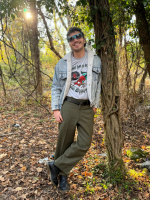In an RV parked outside a church in Baltimore’s Carrollton Ridge neighborhood, Gerald A. Hill Sr. and his co-worker Kenneth Pearson prepare wound care kits for people addicted to opioids.
In recent months, more people have been coming into Baltimore’s mobile opioid harm intervention vans in need of serious wound care due to a drug called xylazine.
Used for decades by veterinarians to tranquilize large animals, xylazine is being used by drug dealers to amp up the effects of fentanyl and other opioids.
However, in humans, the drug causes deep flesh wounds with repeated use that sometimes bore down to the bone.
“It's a dangerous situation because they pass out on the curbs,” Hill said. “People who use the drug’s blood circulation is poor a lot of times. When they come to our van at times, you can smell their wounds, it's really a horrible smell.”
The wound care kits are filled with first-aid supplies like medical tape, gauze and disinfectant. Anyone can board the van and get basic care, pick up kits and exchange used needles for clean ones.
Hill said the vans can easily see 70 people in a day. Some come in with arms ballooned two or three times their size due to infection or with sores that fester and turn black. Not all the wounds are caused by xylazine, which is called tranq on the street, but the drug is increasing the number of people needing care, Hill said.
Hill and Pearson are trying to inform people about Tranq as they hand out kits and exchange needles.
One man, who wanted to remain anonymous due to his drug use, said he’d never heard of the drug, but recognized the symptoms and wondered if his recent sores were caused by Tranq.
Another woman, who preferred not to be named for the same reason, said she had plenty of experience with Tranq.
“It literally just ate the front layer of skin on my leg. It just killed the skin,” she said.
The open sores can be prohibitive to people getting help for addiction as well. Many rehab centers won’t admit people when they have large wounds.
Tranq is insidious in other ways as well. It causes many of the dangerous symptoms of opioids like slowed breathing and heart rate.
“You're basically pouring gasoline on the fire by putting these two drugs [tranq and opioids] together in your system at the same time,” said Keith Humphreys, a professor of behavioral sciences at Stanford University. “Naloxone, which is sometimes called Narcan works very well on fentanyl in terms of reversing the opioid aspects of repressed breathing, but it doesn't have any effect on those caused by xylazine. So that makes our overdose response more challenging.”
Naloxone is an opioid overdose reversal drug.
Tranq is making its way into the illegal opioid supply throughout the nation. The Drug Enforcement Administration found traces of the drug in opioids in at least 48 states and a new Centers for Disease Control and Prevention study found that Tranq was present in 11% of the nation’s opioid overdoses in June.
The drug is much more prominent in Maryland. The CDC found that 80% of opioids tested at eight needle exchange sites in the state had tranq mixed in.
Baltimore provides more extensive care to people suffering from wounds at its SPOT vans. The mobile clinics are staffed with nurse practitioners who can draw blood, conduct tests, prescribe medication and provide some primary care.
Tiffany has been using opioids since she was a teenager. We are only using her first name to protect her privacy. She’s now in her 30s and is full of sores from Tranq.
Nurses on the SPOT van are cleaning her wounds and giving her bandages to take home to ensure her wounds don’t get infected.
“It turned black,” Tiffany said describing one of her wounds. “They want me to go to the hospital because I got more on the back of the leg. I got a big one right here. I got one right here. Right there.”
Tiffany points out sores about the size of a quarter or larger on her arms, legs and stomach. She has one on her shin that is so bad she can’t take the bandage off to show the nurse.
Molly Rice, one of the SPOT van nurses, said she’s seeing more of these cases.
“I definitely would say that we have seen, even since I started six months ago, more and more of these just like pretty aggressive wounds that seem to be from xylazine,” she said. “With any wound or really with any of our patients, unfortunately, a lot of them are on the street, they're living in abandoned buildings. The risk just of infection, just on a day-to-day basis, is so much higher.”
Baltimore is trying to increase awareness about the dangers of tranq as it sees more and more evidence of the drug making its way into the illegal supply.
“We are increasing the number of wound care supplies we are providing,” said Rania Muhammad, the assistant director for community risk reduction services at the Baltimore Health Department.
The city is buying newly available xylazine test strips and continuing to hand out fliers.
Unfortunately, much like fentanyl, the city doesn’t have much control over what goes into illegal opioids and can only react to the devastation they cause.








